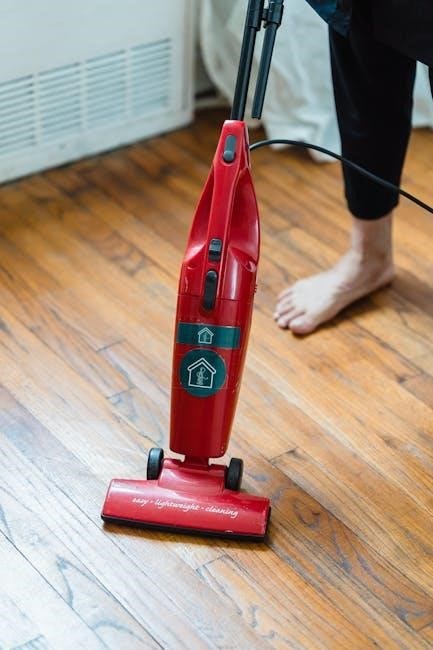
Welcome to the Mitsubishi Electric Mini Split Manual, your comprehensive guide to understanding, installing, and operating your mini-split system. This manual covers essential topics like safety, installation, operation, and maintenance to ensure optimal performance and energy efficiency. By following the guidelines, you can enjoy reliable heating and cooling while minimizing environmental impact. Read carefully to maximize your system’s potential and ensure safe operation.
Overview of the Manual
This manual provides detailed information on the installation, operation, and maintenance of Mitsubishi Electric mini-split systems. It covers essential topics such as safety precautions, system components, and troubleshooting. The guide is designed to help users optimize performance, ensure energy efficiency, and extend the lifespan of their unit. By following the instructions, homeowners and technicians can safely and effectively manage their Mitsubishi Electric mini-split system. The manual is organized into clear sections, making it easy to navigate and reference specific information as needed.
Importance of Reading the Manual
Importance of Reading the Manual

Reading the Mitsubishi Electric mini-split manual is crucial for safe and efficient operation. It provides essential safety precautions, installation guidelines, and maintenance tips to ensure optimal performance. The manual helps users understand energy-saving features and troubleshooting steps, preventing potential hazards like refrigerant leaks. By following the instructions, homeowners can avoid improper installations and ensure compliance with electrical and plumbing requirements. Proper usage extends the system’s lifespan and maintains energy efficiency. Always refer to the manual before installation or operation to guarantee safety and maximize performance.

Safety Precautions
Ensure safe operation by following guidelines to prevent electrical hazards and refrigerant leaks. Proper installation and maintenance reduce risks. Always follow manufacturer instructions carefully.
General Safety Guidelines
Adhere to safety guidelines to prevent hazards. Avoid refrigerant leaks, which can create harmful gases when exposed to fire or heating elements. Ensure proper electrical connections and avoid overloading circuits. Keep the area around the unit dry and clear of flammable materials. Never operate the system near open flames or sparks. Regularly inspect and maintain the unit to prevent malfunctions. Always follow the manufacturer’s instructions for installation, operation, and maintenance. Proper handling ensures safe and efficient performance of your Mitsubishi Electric Mini Split system.
Hazardous Situations to Avoid
Avoid operating the unit near open flames, sparks, or hot surfaces, as refrigerant leaks can ignite, causing fires. Prevent indoor refrigerant exposure to heaters or stoves. Do not operate in high humidity with doors or windows open, as this may cause drain freezing. Avoid overloading circuits and ensure proper electrical connections. Never modify the unit or use damaged power cords. Keep flammable materials away. If refrigerant leaks, ventilate the area and avoid ignition sources. These precautions ensure safe operation and prevent potential risks associated with your Mitsubishi Electric Mini Split system.

Installation Instructions
Ensure proper location selection, electrical connections, and plumbing setup. Follow pre-installation requirements carefully. Level and align units accurately. Check for refrigerant leaks post-installation. Adhere to safety guidelines. Manufacturer specifications must be followed to ensure efficient operation and prevent potential hazards.
Pre-Installation Requirements
Before installing your Mitsubishi Electric mini-split system, ensure the installation site is prepared. Verify that the area is level, clean, and free from obstructions. Check electrical and plumbing connections to meet system specifications. Ensure proper spacing between indoor and outdoor units for optimal airflow. Adhere to local building codes and manufacturer guidelines. Inspect the refrigerant lines and drainage system for any damage or leaks; Ensure all necessary tools and materials are available. Proper preparation ensures a smooth installation process and prevents potential issues. Always follow safety guidelines to avoid hazards during setup.
Step-by-Step Installation Process
The installation begins with mounting the indoor unit, ensuring it is level and securely fastened. Next, the outdoor unit is placed on a sturdy base, maintaining the recommended distance from the indoor unit. Refrigerant lines and electrical connections are then carefully linked between the units. Drainage systems are installed to handle condensate. Electrical power is connected, and the system is tested for leaks. Finally, the system is powered on, and basic functionality is verified. Follow all safety guidelines and manufacturer instructions for a successful installation.
Post-Installation Checks
After installation, ensure all connections are secure and leak-free. Test the system by running a full cycle to confirm proper operation. Check for any unusual noises or vibrations. Verify that the drain system is functioning correctly and that condensate is being discharged properly. Ensure the remote control is paired and functioning as expected. Test all modes, including cooling, heating, and fan-only, to ensure smooth operation. Finally, review the installation with the user, explaining basic functionality and maintenance tips to ensure optimal performance and longevity of the system.
Operating Features
The Mitsubishi Electric Mini Split system offers advanced operating features, including cooling, heating, and fan modes. The remote control allows easy adjustment of settings for optimal comfort. The system also includes a defrosting mode to ensure efficient operation in cold conditions, providing reliable performance year-round.
Cooling and Heating Modes
The Mitsubishi Electric Mini Split system offers versatile cooling and heating modes tailored to various environments. In cooling mode, it efficiently lowers room temperature while maintaining humidity balance, ensuring comfort during summer. The heating mode provides consistent warmth even in cold conditions, with advanced inverter technology optimizing performance. Both modes are designed to adapt to changing temperatures, offering energy-efficient solutions for year-round comfort. The system ensures smooth transitions between modes, maintaining a stable and pleasant indoor climate regardless of outdoor conditions.
Remote Control Functions
The Mitsubishi Electric Mini Split system comes with a remote control that offers intuitive operation. Key functions include adjusting temperature, fan speed, and operating modes (Cool, Heat, Dry, Fan). The remote also features a HI/ECO button for enhanced cooling or heating power. Additionally, it allows scheduling with timers and enables quiet operation for minimal noise. These functions ensure precise control over your environment, optimizing comfort and energy efficiency. The remote’s user-friendly design makes it easy to customize settings and maintain ideal indoor conditions effortlessly.
Defrosting Mode Explanation
The Mitsubishi Electric Mini Split automatically enters defrosting mode during heating operations to remove ice buildup on the outdoor unit. This ensures efficient performance and prevents damage. During defrosting, the system temporarily stops heating, and the outdoor fan may halt. The process is normal and essential for maintaining optimal functionality. The defrosting cycle typically lasts a few minutes, after which the system resumes normal operation. This feature enhances reliability and prolongs the lifespan of your mini-split system, ensuring consistent heating performance throughout the year.
Maintenance and Troubleshooting
Regularly clean filters and check condensate drainage to prevent issues. Defrosting mode ensures ice removal from outdoor units, optimizing performance. Addressing common issues promptly enhances efficiency.
Regular Maintenance Tips
Regular maintenance ensures optimal performance and longevity of your Mitsubishi Electric mini-split system. Clean air filters monthly to improve airflow and energy efficiency. Inspect and clear condensate drainage lines to prevent blockages. Check refrigerant levels annually and ensure proper insulation of pipes. Lubricate fan motors every six months to reduce friction and noise. Schedule professional servicing for complex tasks like compressor inspection and coil cleaning. Regularly check for leaks in refrigerant lines and ensure all electrical connections are secure. Proper maintenance enhances reliability and minimizes the risk of unexpected repairs.
Common Issues and Solutions
Common issues with Mitsubishi Electric mini-split systems include refrigerant leaks, clogged air filters, and frozen drain lines. Refrigerant leaks can cause reduced performance and safety risks, requiring professional repair. Clogged filters decrease efficiency and should be cleaned monthly. Frozen drain lines often result from improper installation; ensure the drain is well-insulated and sloped correctly. If the system doesn’t power on, check circuit breakers and ensure proper electrical connections. For unusual noises or reduced airflow, inspect for blockages or debris. Always refer to the user manual or contact Mitsubishi Electric support for complex issues.

Energy Efficiency
Mitsubishi Electric mini-split systems are designed to maximize energy efficiency with advanced inverter technology and smart sensors, ensuring optimal performance while minimizing energy consumption and environmental impact.
Energy-Saving Features
Mitsubishi Electric mini-split systems offer advanced energy-saving features, including inverter technology that adjusts compressor speed to match demand, reducing energy waste. Smart sensors detect room conditions to optimize performance. The Econo-Cool mode ensures efficient cooling by limiting maximum power consumption. Additionally, the system’s smart defrosting feature prevents unnecessary energy use during heating mode. These features collectively contribute to lower utility bills and reduced environmental impact, making Mitsubishi Electric mini-split systems a highly efficient choice for modern spaces.
Optimizing Performance
To optimize your Mitsubishi Electric mini-split system’s performance, ensure regular maintenance, such as cleaning or replacing air filters to maintain proper airflow. Proper installation location is crucial; avoid direct sunlight or heat sources. Use the remote control to adjust settings like timers and modes for consistent comfort. Cleaning the outdoor unit’s condenser coils and ensuring proper drainage also enhance efficiency. By following these steps, you can maximize energy savings and system longevity, ensuring reliable operation in both cooling and heating modes. Consult the manual for advanced settings and customization options.

Technical Specifications
Mitsubishi mini-split systems include detailed specs for indoor and outdoor units, covering electrical requirements, refrigerant types, and operational capacities. Refer to the manual for precise model-specific details.
Key Components Overview
The Mitsubishi Electric Mini Split system consists of an indoor unit and an outdoor unit. The indoor unit includes an evaporator coil and fan, while the outdoor unit houses the compressor, condenser coil, and expansion valve. Refrigerant flows between these components to facilitate heat exchange. Additional key parts include remote controllers, thermostats, and drainage systems. These components work together to provide efficient heating and cooling. Proper understanding of each part is essential for maintenance and troubleshooting, ensuring optimal performance and longevity of the system. Always refer to the manual for specific model details and configurations.
Electrical and Plumbing Requirements
Proper installation requires adherence to electrical and plumbing guidelines. The system typically operates on 208/230V power, necessitating a dedicated circuit and appropriate wiring. Ensure all electrical connections match the manual’s specifications to avoid hazards. Plumbing involves draining condensate water, which must be directed away from the unit to prevent damage. Regularly inspect and clean drainage systems to maintain efficiency. Always consult a licensed professional for installation to meet safety standards and ensure optimal performance. Proper setup is crucial for reliability, energy efficiency, and longevity of the Mitsubishi Electric Mini Split system.
Warranty and Support

Mitsubishi Electric offers a comprehensive warranty program, typically covering parts and labor for up to 5-7 years, depending on registration and installation compliance. Dedicated customer support provides technical assistance, troubleshooting, and repair services. For extended benefits, register your product online. This ensures seamless access to maintenance, replacements, and expert guidance, enhancing your system’s longevity and performance.
Warranty Coverage
Mitsubishi Electric mini-split systems typically come with a comprehensive warranty program. The standard warranty includes coverage for parts and labor, usually valid for 5-7 years, depending on the model and installation compliance. The compressor, a critical component, is often covered for up to 7 years. To activate the full warranty benefits, proper installation by a certified technician and online registration are required. Extended warranty options may also be available for added protection. Coverage terms vary by region, so reviewing the specific details for your area is essential to understand the scope of protection provided by Mitsubishi Electric;
Customer Service and Technical Support
Mitsubishi Electric offers robust customer service and technical support for mini-split systems. Dedicated service lines provide assistance for inquiries, while online resources include troubleshooting guides and downloadable manuals. Certified technicians are available for installations and repairs, ensuring compliance with warranty terms. The company’s customer portal offers access to product information, FAQs, and repair requests. Technical support specialists can address complex issues, while local service centers ensure prompt resolution. This comprehensive support network enhances user experience, ensuring efficient and reliable operation of Mitsubishi Electric mini-split systems.